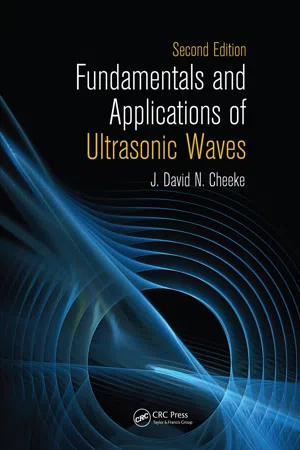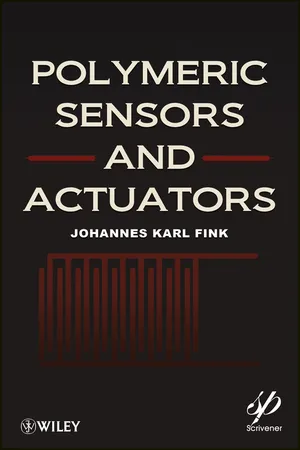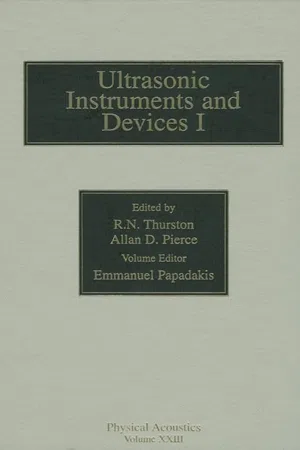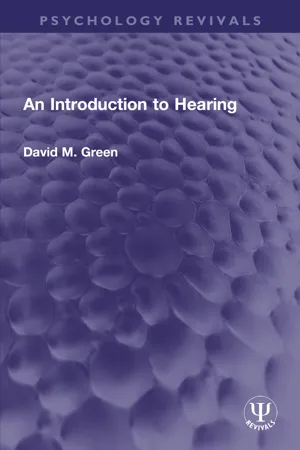Physics
Sound Sensor
A sound sensor is a device that detects sound waves and converts them into electrical signals. It typically consists of a microphone or transducer that captures the sound and a circuit that processes the signal. Sound sensors are used in various applications, such as noise monitoring, audio recording, and in automated systems for detecting sound-based events.
Written by Perlego with AI-assistance
6 Key excerpts on "Sound Sensor"
- J. David N. Cheeke(Author)
- 2017(Publication Date)
- CRC Press(Publisher)
16 Acoustic SensorsA sensor is a device for detecting the presence of a physical, chemical, or biological property and, by appropriate transduction, transforming the detected quantity into an electrical signal. Sensors, in general, are of many types, based on sensing mechanisms that may be electrical, optical, acoustic, magnetic, and so on, in nature. We limit the discussion here to acoustic sensors, which are devices where the environmental property perturbs the acoustic wave. Traditionally, sensors have varied in size from very small to very large devices. We make a further distinction here in that we will concentrate almost exclusively on acoustic microsensors, that is, those fabricated by microelectronic techniques and integrated into silicon or hybrid circuits. Some of the more common microsensors that will be discussed in this chapter are based on acoustic waveguide geometries discussed in Chapter 10 .Acoustic microsensors may be configured as one- or two-port devices. A one-port device, which is active, contains a feedback loop that converts the device into an oscillator. The external perturbation is then manifested as a frequency shift, as shown for a gas sensor in Figure 16.1 . The one-port device has the advantage of simplicity, but some information is lost. This situation is rectified in the two-port passive device, which has an input and output. In this case, amplitude and phase can be measured, but the disadvantage is that extra, bulky instrumentation is needed to convert this into a practical sensor. For this reason, most practical sensors are configured in the oscillator mode. Figure 16.1 shows the response curve of a typical gas sensor. Some of the more important parameters characterizing the sensor can be appreciated from this figure. It is desirable to operate within the linear range for simplicity although a nonlinear response could be handled by adding a look-up calibration table. The resolution of the sensor, the smallest signal that can be measured, is specified by the minimum detectable mass (MDM); it is often determined by the electrical noise in the measuring system. It is essential to distinguish the resolution from the sensitivity; the latter is proportional to the slope of Figure 16.1- eBook - ePub
- Paul P.L. Regtien, Edwin Dertien(Authors)
- 2018(Publication Date)
- Elsevier(Publisher)
Unlike light (electromagnetic waves) that can propagate in a vacuum, sound waves need an elastic medium to travel. The most common waves are longitudinal waves and shear waves. In longitudinal waves the particle motion is in the same direction as the propagation; in shear waves the motion is perpendicular to the propagation direction. Some sensors utilize surface acoustic waves (SAWs). An absorbing substance is deposited on the surface of a device on which the waves are travelling: The SAW's velocity is influenced by the concentration of the absorbed matter. Such SAW devices are suitable for chemical sensing. The selectivity is greatly determined by the chemical interface.In this chapter we only discuss acoustic sensors for the measurement of mechanical quantities in mechatronics, where the propagation medium is generally air. Since the quality of an acoustic measurement strongly depends on the acoustic properties of the medium, we present here an overview of the major acoustic characteristics of air. But first we give some definitions of terms commonly in use in acoustics.9.1.1 Sound intensity and pressure
Any piece of vibrating material radiates acoustic energy. The rate at which this energy is radiating is called the acoustical or sound power (W). Sound intensity is the rate of energy flow through a unit surface area; hence intensity is expressed as W/m2 (compare the optical quantity flux ). A sound wave is characterized by two parameters: the sound pressure (a scalar, the local pressure changes with respect to ambient) and the particle velocity (a vector). The intensity is the time-averaged product of these two parameters. It may vary from zero (when the two signals are 90 degrees out of phase) to a maximum (at in-phase signals). The relation between intensity and pressure in the free field (no reflections) is simply given by the equationI =(9.2)p 2ρ v(9.2)where p is the pressure (in root-mean-square or RMS value), ρ the density, and v the speed of sound. This equation is only valid in a free field.Often sound power, pressure, and intensity are expressed in dB, which means relative to a reference value. Common reference values are: P ref =1 pW, I ref =1 pW/m2 , and p ref - eBook - ePub
- Owen Bishop(Author)
- 2001(Publication Date)
- Newnes(Publisher)
11Sensors and transducers
Although the words ‘sensor’ and ‘transducer’ are often used as if they have the same meaning, their purpose is entirely different. A sensor is a device intended for detecting or measuring a physical quantity such as light, sound, pressure, temperature or magnetic field strength. It has an electrical output (often a varying potential or a current) which varies according to variations in the quantity it is detecting. A transducer is simply a device for converting one form of energy into another form of energy.Some sensors are also transducers. For example, a crystal microphone (p. 118 ) converts the energy of sound waves into electrical potentials. It conveniently converts the sound energy into a form that can be handled by an electronic circuit. But some other sensors are not transducers. For example, a platinum resistance thermometer detects change in temperature as a change in the electrical resistance of its sensing element. Resistance is not a form of energy. Conversely, there are many transducers that are not sensors; examples include electric lamps (convert electrical energy to light energy), electric motors (convert electrical energy to motion), cells (convert chemical energy to electrical energy).Descriptions of transducers begin on page 125. Light sensors and transducers are dealt with separately in Chapter 12 .Temperature sensors
The resistance of metals increases with increasing temperature. If we measure the resistance of wire of known length, diameter and composition, we can determine its temperature. A platinum resistance thermometer consists of a coil of platinum wire wound on a ceramic former. One of its advantages is that it can be used over a very wide range of temperatures, from −100 °C to several hundred degrees Celsius. The resistance of platinum, like that of all metals is very low, so that a long wire is needed for the coil, which is bulky. This means that it takes a relatively long time to acquire the temperature of the surroundings, and also that it is unsuitable for use in measuring the temperature in confined spaces. Finally, the change in resistance is slight and it requires special circuits (p. 62 - eBook - ePub
- Johannes Karl Fink(Author)
- 2012(Publication Date)
- Wiley-Scrivener(Publisher)
Basically, sensor types may be subdivided into optical and electrical sensors, depending on whether the signal is eventually monitored: In an electrical or in an optical way. However, there is still an ambiguity, as an optical signal can be transformed into an electrical signal in a modern spectrometer. If we would use this strict classification, then an optical sensor remains only a device that is evaluated by the naked eye, such as a classical test strip.The forgoing discussion clearly illustrates the problems in attempting a strict classification of sensor types. So, subsequently we will start with an explanation of the basic principles of sensing rather than with a strict classification.1.1.1 Optical Sensors
Optical sensors rely on a change in their optical properties in the presence of an analyte. These changes may be a change in visible color, a change in the fluorescence spectrum, or changes of the IR or UV spectrum. Optical sensors have a large field of use.1.1.2 Acoustic Wave Sensors
Surface acoustic waves were discovered in 1885 by Lord Rayleigh (3). Therefore, they are also addressed as Rayleigh waves. They have a longitudinal and a vertical shear component that can couple with some media that are in contact with the surface. This type of coupling affects the amplitude and velocity of the wave. Sensors based on this property directly sense the mass and the mechanical properties.For a maximum sensitivity, the thickness of the sorption layer should be maximized. The higher the thickness of the layer, the more analyte can be absorbed in the layer, so an increase in the shift of the frequency will be obtained.On the other hand, the slope of the phase decreases with the increasing thickness of the sensitive layer. Now, for a good signal-to-noise ratio the film thickness should be rather minimal. So, in order to find the optimum conditions, a balance is needed (4).The aging effect of surface acoustic wave (SAW) sensors that are coated with viscoelastic polymers is often caused by a dewetting of the surface of the substrate (5). This dewetting often leads to an unwanted decrease of the slope of the phase curve. - eBook - ePub
Reference for Modern Instrumentation, Techniques, and Technology: Ultrasonic Instruments and Devices I
Ultrasonic Instruments and Devices I
- R. N. Thurston, Allan D. Pierce(Authors)
- 1998(Publication Date)
- Academic Press(Publisher)
4Industrial Process Control Sensors and Systems
Lawrence C. Lynnworth Panametrics, Inc., Waltham, MAValentin Mágori Institut für Meβ- und Automatisierungstechnik, Universität der Bundeswehr München, Neubiberg, GermanyI General Remarks on Ultrasonic vs Nonultrasonic Technologies and Sensors; Clamp-On vs Wetted Transducers and Sensors; Wireless Remote Sensing
In the world of homo sapiens , when one refers to an individual’s “sixth sense,” it is not likely that an ultrasonic sensing capability is being acknowledged. Acoustic sensing , however, ranks among the first five of our senses — most of us use ten octaves of its bandwidth as we go about our business or as we take pleasure in listening to birds or music. In this chapter, we will investigate both ultrasonic and acoustic sensing in their various industrial applications.Industrial applications of sound waves may be anticipated at any frequency where a useful effect or useful sensing is obtainable in a practical manner. This chapter is limited to sensing applications primarily in the ultrasonic frequency range from 20 kHz to 2.45 GHz and where the pressure of the interrogating wave is very small compared to the ambient pressure. Also included, however, will be a few applications using audible sound waves, e.g. seismic sensor, an ocean temperature application using an initially high-amplitude carrier having a frequency of 57 Hz, and smokestack temperature and pressure measurements where the frequency of the interrogating pulse, created by an air blast, is on the order of 1 kHz.Sensing may be passive , as simple as listening to the tone, spectrum, or intensity of sound created by flow; or it may be active , analogous to a bat’s echolocation by the two-step process of transmitting and then receiving. The bat, and most ultrasonic instruments, do not merely receive an echo. They interpret the echo, deciding if the insect or flaw is large enough to demand some further action, or so small it can be disregarded. Bats use ultrasound to navigate, and probably to communicate, but they do not appear to have a high-intensity mode of operation to stun their prey. High-intensity ultrasonic applications such as cleaning, welding, reducing friction, and heating, while important in industry and in medicine, are beyond the scope of this chapter. The focus here is on sensing. (Table 1 - eBook - ePub
- David M. Green(Author)
- 2021(Publication Date)
- Routledge(Publisher)
1The Physical Nature of Sound
INTRODUCTION
The human senses are all remarkably acute. Under optimal conditions, the eye can detect a few photons. The skin can detect a vibratory stimulus that moves only a few microns. The ear can detect, at about 3,000 Hz (cycles per second), movements of the eardrum about a hundred times smaller than the diameter of a hydrogen molecule.How is such sensitivity possible? How can the ear detect such minute vibrations? Why does the random vibration of the molecules in the air not obscure such faint sounds? These are some questions that arise in studying auditory perception. To understand in detail the answers to such questions, we must have a firm grasp of the physical nature of sound. Indeed, one of our goals is to understand the relation between what we hear and its physical properties.We begin, then, by first considering what a sound wave is, how it is propagated, and what the rules are that govern its behavior. Answering these questions involves defining the units used to describe the intensity or energy of the sound wave. We review here several formulas specifying the intensity of the sound wave. We also discuss sinusoidal wave motion, in part because the absolute sensitivity of the ear depends strongly on the frequency of the signal. Finally, reflection of sound waves and resonance is discussed. This background material will permit us to answer some of our initial questions about absolute sensitivity. We begin by considering the nature of sound.WHAT IS SOUND?
In ordinary usage the word “sound” refers to that which is heard. However, we want to understand the relation between what we hear and the physical aspects of sound. We therefore begin with a consideration of sound as a physical entity. From a physical viewpoint, sound is a mechanical disturbance that is propagated through an elastic medium. This physical disturbance alters certain properties of the medium, and the rapid variation of one of them, for example, the variation of pressure as a function of time, might be called the sound wave. We are primarily interested in this mechanical disturbance as it moves in air, but sound can also move in liquid or solid structures as well. Air is composed of a mixture of molecules, the majority being oxygen, nitrogen, and hydrogen. The molecules of a gas move about freely in space, colliding with other molecules or any surface containing the gas. The mass of the molecules and the velocity of their motion determine the temperature of the gas. These factors, along with the number of molecules per unit volume, also determine how far, on the average, molecules travel before colliding with other molecules. The gas molecules wander about at random in an undisturbed state. As a result of their collisions with other objects, they create a net static pressure
Index pages curate the most relevant extracts from our library of academic textbooks. They’ve been created using an in-house natural language model (NLM), each adding context and meaning to key research topics.
Explore more topic indexes
Explore more topic indexes
1 of 6
Explore more topic indexes
1 of 4





